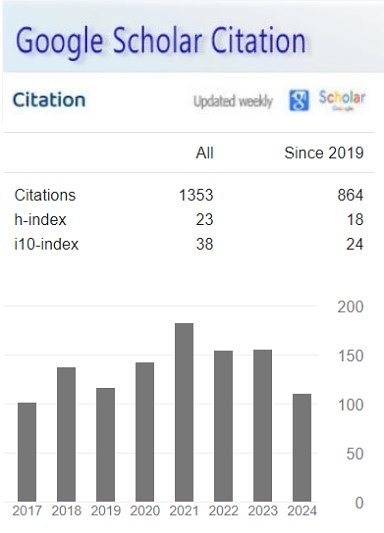Using power of calculated electrons to cut, analyze and exterminate the outer and the inner biological elements of hepatitis C virus without blood parameters disorders: In vitro study: low potential codified ions for hepatitis therapy
Keywords:
Abstract
Recently, the prevention and treatment of hepatitis C virus (HCV) complications consider as major obstacles to reducing HCV outbreaks worldwide. Therefore, it is crucial to develop a new alternative therapy for HCV infection with low cost and low side effects. A smart device termed a Life Restoration Device (LRD) was designated to produce a low potential codified amount of ions. The specified codified amount of ions produced from LRD are designated to exterminate HCV. To investigate our hypothesis, we designated an experimental system for in-vitro studies. This system is composed of a glass tube that can be filled with HCV polymerase chain reaction (PCR)-positive serum. The result of this study showed that LRD can decrease the viral load of HCV PCR-positive serum to 99% after 2 hrs treatment. The viral load reduction of the LRD against low HCV PCR count was almost similar to that of high HCV PCR count. Furthermore, the efficacy of LRD to reduce the serum viral load after 30 min or 60 min treatment was 74%or 95% respectively while the viral load after2 hrs treatment was about 91%. The electron microscopy investigation of HCV PCR-positive serum after treatment with LRD showed degenerated HCV particles compared with the non-treated virus. The in vitro treatment of the HCV PCR-positive serum with LRD didn’t affect the blood contents such as red blood cells count, white blood cells count and hemoglobin levels. The sincerity of the codified amount of ions produced by LRD may affect the fragile fluidity of the viral envelope. Treatment of hepatitis viruses with a codified amount of ions is a new alternative therapy but needs more studies. It is crucial to develop an effective alternative viral therapy using such kind of technology to reduce the antiviral drugs side effects.
References
Lavanchy D. (2008). Chronic viral hepatitis as a public health issue in the world. Best practice & research. Clinical gastroenterology, 22(6), 991–1008. https://doi.org/10.1016/j.bpg.2008.11.002 DOI: https://doi.org/10.1016/j.bpg.2008.11.002
SHERMAN, I. L., & EICHENWALD, H. F. (1956). Viral hepatitis: descriptive epidemiology based on morbidity and mortality statistics. Annals of internal medicine, 44(6), 1049–1069. https://doi.org/10.7326/0003-4819-44-6-1049 DOI: https://doi.org/10.7326/0003-4819-44-6-1049
Trepo C. (2014). A brief history of hepatitis milestones. Liver international : official journal of the International Association for the Study of the Liver, 34 Suppl 1, 29–37. https://doi.org/10.1111/liv.12409 DOI: https://doi.org/10.1111/liv.12409
Razavi H. (2020). Global Epidemiology of Viral Hepatitis. Gastroenterology clinics of North America, 49(2), 179–189. https://doi.org/10.1016/j.gtc.2020.01.001 DOI: https://doi.org/10.1016/j.gtc.2020.01.001
Kim, H. S., & El-Serag, H. B. (2019). The Epidemiology of Hepatocellular Carcinoma in the USA. Current gastroenterology reports, 21(4), 17. https://doi.org/10.1007/s11894-019-0681-x DOI: https://doi.org/10.1007/s11894-019-0681-x
Levrero, M., & Zucman-Rossi, J. (2016). Mechanisms of HBV-induced hepatocellular carcinoma. Journal of hepatology, 64(1 Suppl), S84–S101. https://doi.org/10.1016/j.jhep.2016.02.021 DOI: https://doi.org/10.1016/j.jhep.2016.02.021
Monaco, S., Mariotto, S., Ferrari, S., Calabrese, M., Zanusso, G., Gajofatto, A., Sansonno, D., & Dammacco, F. (2015). Hepatitis C virus-associated neurocognitive and neuropsychiatric disorders: Advances in 2015. World journal of gastroenterology, 21(42), 11974–11983. https://doi.org/10.3748/wjg.v21.i42.11974 DOI: https://doi.org/10.3748/wjg.v21.i42.11974
González-Grande, R., Jiménez-Pérez, M., González Arjona, C., & Mostazo Torres, J. (2016). New approaches in the treatment of hepatitis C. World journal of gastroenterology, 22(4), 1421–1432. https://doi.org/10.3748/wjg.v22.i4.1421 DOI: https://doi.org/10.3748/wjg.v22.i4.1421
Teodor, D., Teodor, A., Grigore, L., Jugănariu, G., Dorobăţ, C. M., Miftode, E., & Azoicăi, D. (2012). Side effects of antiviral therapy in hepatitis C virus infection-sarcoidosis - case report. Revista medico-chirurgicala a Societatii de Medici si Naturalisti din Iasi, 116(4), 1039–1043.
Mayberry, J., & Lee, W. M. (2019). The Revolution in Treatment of Hepatitis C. The Medical clinics of North America, 103(1), 43–55. https://doi.org/10.1016/j.mcna.2018.08.007 DOI: https://doi.org/10.1016/j.mcna.2018.08.007
Bailey, J. R., Barnes, E., & Cox, A. L. (2019). Approaches, Progress, and Challenges to Hepatitis C Vaccine Development. Gastroenterology, 156(2), 418–430. https://doi.org/10.1053/j.gastro.2018.08.060 DOI: https://doi.org/10.1053/j.gastro.2018.08.060
Cox A. L. (2020). Challenges and Promise of a Hepatitis C Virus Vaccine. Cold Spring Harbor perspectives in medicine, 10(2), a036947. https://doi.org/10.1101/cshperspect.a036947 DOI: https://doi.org/10.1101/cshperspect.a036947
Bean P. (2002). The use of alternative medicine in the treatment of hepatitis C. American clinical laboratory, 21(4), 19–21.
Yang, Z., Zhuang, L., Lu, Y., Xu, Q., & Chen, X. (2014). Effects and tolerance of silymarin (milk thistle) in chronic hepatitis C virus infection patients: a meta-analysis of randomized controlled trials. BioMed research international, 2014, 941085. https://doi.org/10.1155/2014/941085 DOI: https://doi.org/10.1155/2014/941085
Hart, H., Reid, K., & Hart, W. (1993). Inactivation of viruses during ultraviolet light treatment of human intravenous immunoglobulin and albumin. Vox sanguinis, 64(2), 82–88. https://doi.org/10.1111/j.1423-0410.1993.tb02523.x DOI: https://doi.org/10.1159/000462316
Roberts, P., & Hope, A. (2003). Virus inactivation by high intensity broad spectrum pulsed light. Journal of virological methods, 110(1), 61–65. https://doi.org/10.1016/s0166-0934(03)00098-3 DOI: https://doi.org/10.1016/S0166-0934(03)00098-3
Takubo, T., Tatsumi, N., Satoh, N., Matsuno, K., Fujimoto, K., Soga, M., Yamagami, Y., Akiba, S., Sudoh, T., & Miyazaki, M. (2002). Evaluation of hematological values obtained with reference automated hematology analyzers of six manufacturers. The Southeast Asian journal of tropical medicine and public health, 33 Suppl 2, 62–67.
Rabaan, A. A., Al-Ahmed, S. H., Bazzi, A. M., Alfouzan, W. A., Alsuliman, S. A., Aldrazi, F. A., & Haque, S. (2020). Overview of hepatitis C infection, molecular biology, and new treatment. Journal of infection and public health, 13(5), 773–783. https://doi.org/10.1016/j.jiph.2019.11.015 DOI: https://doi.org/10.1016/j.jiph.2019.11.015
Adinolfi, L. E., Nevola, R., Lus, G., Restivo, L., Guerrera, B., Romano, C., Zampino, R., Rinaldi, L., Sellitto, A., Giordano, M., & Marrone, A. (2015). Chronic hepatitis C virus infection and neurological and psychiatric disorders: an overview. World journal of gastroenterology, 21(8), 2269–2280. https://doi.org/10.3748/wjg.v21.i8.2269 DOI: https://doi.org/10.3748/wjg.v21.i8.2269
Tanwar, S., Rhodes, F., Srivastava, A., Trembling, P. M., & Rosenberg, W. M. (2020). Inflammation and fibrosis in chronic liver diseases including non-alcoholic fatty liver disease and hepatitis C. World journal of gastroenterology, 26(2), 109–133. https://doi.org/10.3748/wjg.v26.i2.109 DOI: https://doi.org/10.3748/wjg.v26.i2.109
Kim, A. I., & Saab, S. (2005). Treatment of hepatitis C. The American journal of medicine, 118(8), 808–815. https://doi.org/10.1016/j.amjmed.2005.01.073 DOI: https://doi.org/10.1016/j.amjmed.2005.01.073
Younossi Z. M. (2017). Hepatitis C Infection: A Systemic Disease. Clinics in liver disease, 21(3), 449–453. https://doi.org/10.1016/j.cld.2017.03.001 DOI: https://doi.org/10.1016/j.cld.2017.03.001
Kaniusas, E., Szeles, J. C., Kampusch, S., Alfageme-Lopez, N., Yucuma-Conde, D., Li, X., Mayol, J., Neumayer, C., Papa, M., & Panetsos, F. (2020). Non-invasive Auricular Vagus Nerve Stimulation as a Potential Treatment for Covid19-Originated Acute Respiratory Distress Syndrome. Frontiers in physiology, 11, 890. https://doi.org/10.3389/fphys.2020.00890 DOI: https://doi.org/10.3389/fphys.2020.00890
Kumagai, E., Tominaga, M., & Harada, S. (2004). Sensitivity of chronically HIV-1 infected HeLa cells to electrical stimulation. Applied microbiology and biotechnology, 63(6), 754–758. https://doi.org/10.1007/s00253-003-1410-8 DOI: https://doi.org/10.1007/s00253-003-1410-8
Kumagai, E., Tominaga, M., & Harada, S. (2011). Sensitivity to electrical stimulation of human immunodeficiency virus type 1 and MAGIC-5 cells. AMB Express, 1(1), 23. https://doi.org/10.1186/2191-0855-1-23 DOI: https://doi.org/10.1186/2191-0855-1-23
Mearini L. (2013). High intensity focused ultrasound, liver disease and bridging therapy. World journal of gastroenterology, 19(43), 7494–7499. https://doi.org/10.3748/wjg.v19.i43.7494 DOI: https://doi.org/10.3748/wjg.v19.i43.7494
Song, H., Li, J., Shi, S., Yan, L., Zhuang, H., & Li, K. (2010). Thermal stability and inactivation of hepatitis C virus grown in cell culture. Virology journal, 7, 40. https://doi.org/10.1186/1743-422X-7-40 DOI: https://doi.org/10.1186/1743-422X-7-40
Kojima, J., Shinohara, H., Ikariyama, Y., Aizawa, M., Nagaike, K., & Morioka, S. (1991). Electrically controlled proliferation of human carcinoma cells cultured on the surface of an electrode. Journal of biotechnology, 18(1-2), 129–139. https://doi.org/10.1016/0168-1656(91)90241-m DOI: https://doi.org/10.1016/0168-1656(91)90241-M
Harada, S., Yusa, K., Monde, K., Akaike, T., & Maeda, Y. (2005). Influence of membrane fluidity on human immunodeficiency virus type 1 entry. Biochemical and biophysical research communications, 329(2), 480–486. https://doi.org/10.1016/j.bbrc.2005.02.007 DOI: https://doi.org/10.1016/j.bbrc.2005.02.007
Hawes, P. C., Netherton, C. L., Wileman, T. E., & Monaghan, P. (2008). The envelope of intracellular African swine fever virus is composed of a single lipid bilayer. Journal of virology, 82(16), 7905–7912. https://doi.org/10.1128/JVI.00194-08 DOI: https://doi.org/10.1128/JVI.00194-08
Nicolson G. L. (2013). Update of the 1972 Singer-Nicolson Fluid-Mosaic Model of Membrane Structure. Discoveries (Craiova, Romania), 1(1), e3. https://doi.org/10.15190/d.2013.3 DOI: https://doi.org/10.15190/d.2013.3
Delaunay J. (1977). The enzymes of the red blood cell plasma membrane. Biomedicine / [publiee pour l'A.A.I.C.I.G.], 26(6), 357–361.
Gravemann, U., Handke, W., Lambrecht, B., Schmidt, J. P., Müller, T. H., & Seltsam, A. (2018). Ultraviolet C light efficiently inactivates nonenveloped hepatitis A virus and feline calicivirus in platelet concentrates. Transfusion, 58(11), 2669–2674. https://doi.org/10.1111/trf.14957 DOI: https://doi.org/10.1111/trf.14957
Vercauteren, K., Mesalam, A. A., Leroux-Roels, G., & Meuleman, P. (2014). Impact of lipids and lipoproteins on hepatitis C virus infection and virus neutralization. World journal of gastroenterology, 20(43), 15975–15991. https://doi.org/10.3748/wjg.v20.i43.15975 DOI: https://doi.org/10.3748/wjg.v20.i43.15975
Yost, S. A., Wang, Y., & Marcotrigiano, J. (2018). Hepatitis C Virus Envelope Glycoproteins: A Balancing Act of Order and Disorder. Frontiers in immunology, 9, 1917. https://doi.org/10.3389/fimmu.2018.01917 DOI: https://doi.org/10.3389/fimmu.2018.01917
Published
How to Cite
Issue
Section
License
Copyright (c) 2022 Asian Journal of Applied Science and Engineering

This work is licensed under a Creative Commons Attribution-NonCommercial 4.0 International License.








